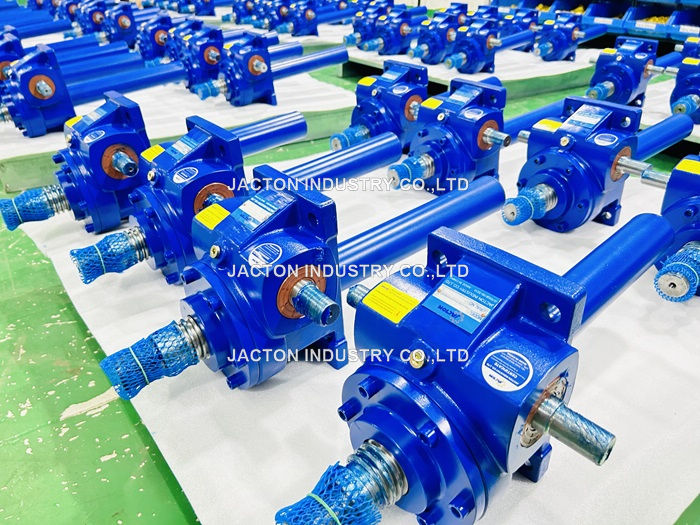A There are 3 main types of screw jacks: worm gear machine screw jacks, worm gear ball screw jacks, and bevel gear screw jacks. Within these, there are 3 subcategories related to the mode of operation: Translating, Keyed, and Rotating nut. They have different types in relation to the application. Understanding each of the designs is foundational to selecting the suitable type for your specific applications.

Machine screw jacks that are properly selected and maintained will reliably lift, position, support or hold industrial loads for years. Incorporating them into mechanized applications is a fairly simple matter once jack designs are understood. The basic components of machine screw jacks are lifting screw, gear set, and thrust bearing.
Ball screw jacks include ball nuts that are about 90% efficient so the jacks require much less energy to lift an equal load than their machine screw jack counterpart. They are NOT self-locking so a brake motor needs to be included in the drive system and hand wheels are not a recommended option. Mechanical worm gear ball screw jack, available with translating lifting screw or lifting nut. Standard lifting screw length up to 6 m. Not self-locking, must be combined with a brake arrangement. Ball Screw jack with Translating Lifting Screw. Ball Screw jack with Lifting nut.
Bevel Gear Screw Jacks offer higher efficiency and greater speed than other mechanical worm gear screw jacks. As an added benefit, bevel gear jacks also act as right angle gearboxes, making them an ideal choice for multi-jack systems. There are no "standard" travel lengths and each bevel gear screw jack is built to specification. All high bevel gear screw jacks are equipped with hardened, sharpened and spiral toothed bevel gear transmissions for high lifting speed and greater duty cycle. Bevel Gear Machine Screw Jacks incorporate the use of a trapezoidal acme screw. Bevel Gear Screw Jack systems are ruggedly designed and produced in standard models with load handling capacities 20 tons. They may be used individually or in multiple arrangements.
Rotating Screw Jack(Nut Traveling): A rotating jack has a lifting screw that moves a nut as it turns. The lifting screw is fixed to the worm gear. This causes the load, which is attached to the travel nut, to move along the lifting screw.
Translating Screw Jacks: A translating jack has a lifting shaft that moves through the gear box. A nut is integrated with the worm gear such that the worm gear nut rotate together. When the lifting screw is held to prevent rotation, the lift shaft will move linearly through the gear box to move the load.
Keyed Screw Jacks for Non-Rotation: A feature can be added to a machine screen jack to prevent lifting screw rotation. This type of jack is referred to as a "keyed jack" and is available in upright and inverted models. A keyed jack has a keyway machined along the length of the lifting screw. A matching key is fastened to the cover of the jack which will eliminate lift shaft rotation.
Double Clevis Screw Jacks are used when it is necessary to move a load through an arc, such as tracking antennas, hinged doors or air dampers, Machine Screw and Ball Screw Jacks from 1 ton to 35 ton capacities can be supplied with double clevis mounts. One clevis is welded to a heavy duty stem cover, which is welded to the housing. Double clevis designs are available with optional accessories such as boots, motor mounts, right angle reducers, motors, encoders and rotary limit switches.
Anti-backlash Screw Jacks are used wherever reversible load conditions require precision positioning control. Adjustable backlash Screw Jack models are available to reduce backlash. The unit allows the lash between the drive sleeve and the Work Screw thread(1) to be accurately controlled by the relative position of the upper (2) and lower (3) drive sleeves. Adjustment of the cover (4), by loosing set Screws (5), changes the relative distance between the sleeves. This change in distance compensate for any slash. Axial backlash should be minimized but not completely eliminated, the result would be a lock-up of the Jack. When top plate touch the Jack body, the Jack wear is at the limit and Jack shall be revised.
Self locking machine screw jacks with anti-backlash and ball screw jacks must be considered separately, as the normal backlash will vary due to different constructions. Ball screw jacks do not have an anti-backlash option similar to the machine screw jacks. Instead for zero or reduced axial play ball screw jacks can be ordered with a pre-loaded ball nut.

